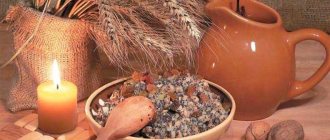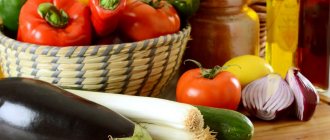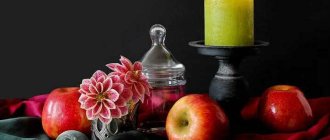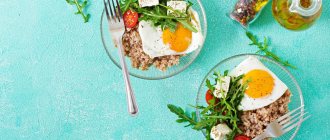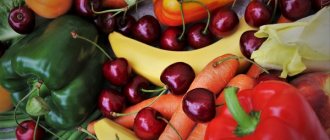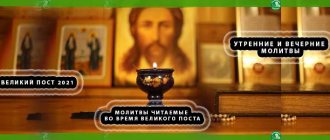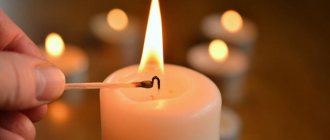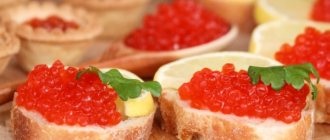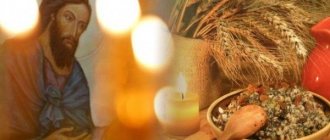Lent should not be treated as a diet. Dietary restrictions during this period have a special meaning. During Lent, the soul is called upon to do great work, remembering that every Orthodox Christian must strengthen his faith. Fasting cleanses the soul, prevents the penetration of temptations and sinful thoughts into it, stands guard over spiritual purity, serves as a manifestation of solidarity with the entire Christian world, and creates a mood for prayer.
Before the start of Lent, you need to familiarize yourself with the rules of eating and thoroughly think through your menu. A daily nutrition calendar for the laity will help with this, which will detail the days when you can eat hot food, when you need to fast, and when you are allowed to cook food with oil.
When does Lent begin in 2021?
Orthodox Christians observe several fasts throughout the year. Lent is the longest and strictest. Its start is not tied to a specific calendar date. Every year Lent begins on a different date. Believers can easily determine the occurrence of this event by looking at the church calendar. But the duration of Lent is always the same - 48 days.
In 2021, Lent begins on Monday 15 March and ends on Saturday 1 May.
The beginning of Lent is preceded by Forgiveness Sunday (Maslenitsa). The strictest days of fasting occur during Holy Week (from April 26 to May 1). At this time, Christians should spend more time in prayer, remember the suffering of Jesus, honor and glorify him. The soul must be cleansed by repentance; Orthodox Christians need to pacify their passions and emotions. Lent ends with Easter - the feast of the Resurrection of Christ; on this day believers break their fast.
On a note! Over the centuries-old history, the traditions of Great Lent have undergone significant changes.
In early Christianity, the Resurrection of Christ was celebrated weekly on Fridays (the day of Jesus' death on the cross). The modern custom has evolved over centuries. The duration of the fast and the degree of its severity changed. The tradition of a 40-day fast was finally formed in the 4th century. Since then, this time has also been called Pentecost.
How to fast correctly
What should believers be guided by in their behavior during fasting? The regulations are spelled out in the church charter and are recommended for compliance by all Orthodox Christians. According to his rules, there are five degrees of severity of fasting days:
- complete hunger;
- xerophagy;
- hot food without oil;
- dishes with added oil;
- eating fish.
The church charter prescribes complete abstinence from food during the first 2 days of Lent and on Friday of Holy Week. On other weekdays, it is allowed to eat plant foods without adding oil.
On Saturdays and Sundays, the fast is weakened; you can eat thermally processed food with the addition of vegetable oil twice a day.
Fast food should be completely excluded from the diet. Believers can afford fish on Annunciation and Palm Sunday, and on Lazarus Saturday they can nourish the body with fish caviar. The listed restrictions can be considered canonical. Today, they are being deviated from in favor of less strictness.
On a note! The priests also allow a weakened fast for pregnant and lactating people, sick people, and children under 14 years of age. If you have the intention to observe fasting, but have any doubts, you can turn to the priest for clarification.
During fasting days, believers must sincerely repent and try not to burden themselves with new sins. The Church says that this time is suitable for reconciliation with one’s enemies and giving alms. You should not envy your neighbor and succumb to temptations. Backbiting during this period is also considered a grave sin.
This time is designed to cleanse the soul so that it can feel joy and enjoy everyday life. Moreover, the joyful day of the Resurrection of Christ lies ahead, when a holiday begins in the heart of any believer.
Second week: how to eat properly during this time
The next week will be much easier, especially if you managed not to break the fast in the first days:
1. From Monday it is allowed to eat any raw food without oil. At the same time, you should not overeat - everything should be in moderation so as not to harm your body.
2. Tuesday is a day of hot food, to which no oil is added. It can be quite tasty and varied if you think through the menu for the day in advance and buy everything you need.
3. On Wednesday, the transition to dry eating occurs again, that is, only raw foods without oil and with a small amount of salt (if necessary) can be on the table.
4. On Thursday, hot Lenten dishes are prepared, but without oil and a lot of spices.
5. But on Friday you need to switch to raw food without oil again. It is best to focus on eggplants, peanuts and other nuts. For sweets, honey and halva are allowed.
6. On weekends, the emphasis is on hot dishes, to which you can add a little vegetable oil. On Sunday, in addition, every believer can drink a little wine.
How to prepare for Lent in 2021
Preparing for fasting will make it easier to endure the upcoming restrictions. Abstinence should not allow health to deteriorate or loss of strength to occur. For those who have health problems, it is better to consult with your doctor before starting to eat lean foods. Even if you are absolutely healthy, be prepared for the fact that during the first days of fasting you will still experience a feeling of weakness and fatigue.
When preparing for fasting, you need to eat in small portions. Some prepared meals should be replaced with fresh vegetables and fruits. During the preparatory period, you need to drink a lot of fluids (water, natural juices, herbal teas).
During Cheese Week (Maslenitsa week) from March 8 to March 14, it is necessary to observe moderation in food, switch to lean foods, and exclude meat dishes from the diet. During this period, pancakes are baked and treated to friends and family.
- Read also: Maslenitsa in 2021, what date do Orthodox Christians have in Russia, how to celebrate the holiday by day
Restrictions before fasting should not only be in food, but it is also necessary to give up anger, evil thoughts, envy and condemnation of other people.
On the eve of Lent, on Forgiveness Sunday (March 14), we need to ask for forgiveness from those whom we unwittingly offended in order to enter Lent with a pure soul and peace.
Considering your state of health and lifestyle, before starting fasting, it is better to consult with doctors and clergy, and determine how to fast and how to eat properly these days.
The spiritual component of fasting: what needs to be done
Archpriest Vladimir Vigilyansky, rector of the Church of the Holy Martyr Tatiana at Moscow State University, simply and succinctly spoke about the spiritual component of fasting on his Facebook page. M.V. Lomonosov. You couldn't say it better.
1. Learning to pray.
Let's add something else to what we have. If we don’t pray at all at home, then we do at least a short, but regular prayer. If we perform the morning and evening rule, then we begin daily either to read the Psalter or a chapter from the Gospel. If we go to church only on Sunday, then we add at least one more day to weekdays.
2. Learning to fight sins. I suggest choosing the smallest of all the repeated sins and trying to overcome it. Well, for example, the skill of expressing your dissatisfaction with everything you see or hear. Or discuss third parties with a close friend. Or use swear words in conversation. Or holding an old grudge against a relative (boss, teacher, neighbor, etc.). How to overcome this? Pray for him daily.
3. Learn to repent. We select the most secret sins from the list - those that are hidden from the eyes of others and for which we are especially ashamed. We go to confession and ask the priest how to deal with them. The priest is an experienced person, he will certainly advise what is needed.
4. We learn to do good deeds. “For I was hungry, and you gave me food; I was thirsty and you gave Me something to drink; I was a stranger and you accepted Me; I was naked and you clothed Me; I was sick and you visited Me; I was in prison, and you came to Me” (Matthew 25:35-36). Every day in the evening we examine our conscience: what good deed have I done today? Whom did you console, whom did you help, who did you give time to, etc.? If this did not happen, then realize that the day was lived in vain.
5. Learning to rejoice. The beauty of God's world. God's gifts and talents that people are endowed with. Manifestations of love, compassion, mercy. Finding meaning, logic, harmony, truth. In short, everything that brings us closer to God.
Features of nutrition during Lent
Those who begin to fast for the first time do not always have reliable knowledge about permitted and prohibited foods during Lent. Meanwhile, it is food restrictions that constitute an important part of fasting.
What can you eat during Lent: list of products
Plant foods and dishes made from them are ideal for a Lenten table. In addition, cereals make up an important part of the diet. Legumes, nuts, mushrooms, herbs, flour products and some types of sweets will help saturate the body. During Lent you can add to your menu:
- Cereal products - buckwheat, rice, semolina, oatmeal, barley and wheat groats. Porridge contains a lot of carbohydrates, so this food quickly fills you up. In addition, all cereals contain a set of microelements and vitamins.
- Fruits and vegetables. In this category, any fruit is acceptable without restrictions. You can prepare dishes from potatoes, beets, turnips, carrots, pumpkins, cabbage, corn, cucumbers, onions, garlic, and tomatoes. Sweet fruits can easily replace dessert. Bananas, oranges, apples, pears, pomegranates are very tasty and healthy.
- Mushrooms are considered a satisfying food, quite capable of replacing meat. During the fasting period, you can eat oyster mushrooms, champignons, dry and frozen forest mushrooms. These products contain important amino acids, vitamins and minerals.
- Legumes. In stores you can easily find beans, peas, lentils, and chickpeas. These products are good because they contain a lot of vegetable protein.
- Nuts. Any are acceptable: peanuts, hazelnuts, almonds, cashews. They can be supplemented with pumpkin and sunflower seeds. These products give you a feeling of satiety and contain many substances beneficial to the body.
- Dried fruits. By the beginning of Lent, you can stock up on prunes, dried apricots, raisins, figs, and dates. Compote made from dried fruits will be an excellent vitamin-rich dessert. Nuts and dried fruits can also be added to porridge and salads.
- Pasta. All of them quickly give you a feeling of fullness. Preference should be given to those products that do not contain egg yolk.
- Bread and pastries. This same group of products can include bread made from rye flour, crispbread, biscuits, and crackers. Baking should be without eggs and milk.
Vegetable oil (all types) and herbs will be an excellent addition to any dish. An important part of the menu during Lent consists of pickles and fermented foods. Kozinaki, halva, and jam are acceptable as sweets. However, their intake during fasting should still be limited, since these products are considered a delicacy.
What drinks can you drink?
A drink like tea is perfect for fasting. You can use black and green varieties. In addition, tea is prepared based on fruits and herbs:
- ginger;
- rosehip;
- raspberries;
- lemon balm;
- mint;
- oregano;
- St. John's wort.
Among hot drinks, sbiten based on honey and spices is also popular. You can make fruit smoothies with coconut milk. Fruit drinks, jelly, compotes, and homemade lemonade allowed during Lent are tasty and healthy.
What products are prohibited?
During fasting, you should not eat products obtained from animals. These include:
- all types of meat;
- bird;
- fish (sometimes allowed);
- eggs;
- dairy products;
- animal fats;
In addition, you should not eat dishes where these products may be included as additional ingredients. Now stores sell lean cheese, mayonnaise, and rye bread. Such products can be purchased as a replacement for regular ones.
Also prohibited: strong alcohol, white bread and chocolates.
List of nutritious Lenten foods for the laity
Here are the best food products that fit into the framework of Lent and supply the body with many valuable substances to maintain health, vigor and good mood:
- different types of table vinegars;
- edible seaweed;
- lean bread (lavash or other bread products with a neutral composition);
- tomato paste and ketchup;
- lean mayonnaise;
- adjika and many other sauces;
- all types of nuts;
- all types of seeds;
- honey;
- pasta and flour products without unnecessary ingredients;
- dried fruits;
- all types of cereals (a good option is porridge with dried fruits);
- mushrooms;
- legumes (for example, lentils, peas, beans);
- fish and caviar (as well as shrimp, squid, all this is possible on certain days according to the calendar);
- seasonal and exotic fruits (the more variety of fruits, the better);
- seasonal vegetables (you can prepare a lot of healthy dishes from vegetables, eat them pickled and salted, for example, cabbage, beets, carrots, celery);
- homemade sweets (fruit and berry preserves, jam);
- lean chocolate;
- milk (coconut, soy and other types);
- drinks (decoctions and infusions of herbs, teas, coffee, jelly, compote, juices, fruit drinks);
- soy yogurt and cheese;
- lean marshmallows;
- marmalade;
- berries;
- Turkish Delight;
- halva and kozinaki;
- sugar and candy;
- Korean dishes (salads).
When the Great Orthodox Lent begins, there is no need to suddenly change your diet and go hungry for a long time.
As you already understand, by abstaining from all meat and dairy foods during Lent, lay people do not need to torture themselves and greatly limit themselves. On the contrary, variety and lightness should reign in the home kitchen of Lent. Strict restrictions are intended for highly spiritual persons carrying out a feat. Lent: this time is intended for good deeds, prayers, seeking measures to become better, comprehensive cleansing of the soul and body, eating light food, resting from animal products
Nutrition calendar for Lent 2021 by day for the laity
Before the start of Lent, you need to thoroughly think through your diet. The Lenten menu can be made tasty, satisfying, varied and healthy.
Each week of Lent has its own characteristics. The Great Lent 2021 nutrition calendar will tell you about this in detail by day with a description. Once you start fasting, you should not give up this activity, bring it to the end. Prayers and visits to church will help strengthen believers in this intention.
Meals in the first week from March 15 to 21
The first week of Great Lent is considered the strictest. It starts with Clean Monday (March 15). This date is very important from the point of view of the church. On Clean Monday, believers must rid themselves of all the negativity accumulated over the year. Churches hold special liturgies. It is advisable for believers to attend a service in a temple or pray at home, asking others for forgiveness for their bad deeds and unclean thoughts.
On this day it is also a good idea to start reading spiritual literature. You should avoid watching television; it is better to devote your free hours to communicating with God. On the physical plane, it is also necessary to carry out a cleansing ritual - to clean the home and wash the body. It’s best to go to the bathhouse, or you can just take a bath.
- 15.03 Monday – only drinking clean water is allowed. Food on this day should be exclusively spiritual.
- 16.03 Tuesday – abstaining from food, drinking only water is allowed. (if for health reasons it is not possible to fast for two days, then you can adhere to dry eating on this day and eat stale lean bread or crackers, drink water.
- 17.03 Wednesday; 18.03 Thursday; 19.03 Friday - from Wednesday to Friday of the first week you need to observe dry eating. Food should not be heat treated. They don’t use butter these days either. Fasting people should limit themselves to nuts, seeds, fruits, dried fruits, raw vegetables, herbal infusions, and fruit drinks.
- 20.03 Saturday - 21.03 Sunday - hot food with added vegetable oil is acceptable. You can prepare mushroom or vegetable soup, porridge, eat boiled potatoes with pickles or vegetable stew.
During the first 7 days, the body gets used to dietary restrictions. In the future, the post will be easier to bear.
Meals in the second week from March 22 to 28
The second week of Lent is less strict than the first, since there are no days of complete food refusal. Dry eating days are Monday, Wednesday and Friday.
During Lent, homemade preparations are very helpful for believers. Canned, salted and pickled vegetables, frozen and dried fruits, jams and preserves are used.
- 22.03 Monday; 24.03 Wednesday; 26.03 Friday – days of dry eating . You cannot boil, fry or bake foods. On these days, vegetables, fruits, dried fruits, candied fruits, nuts, seeds, honey, non-hot herbal infusions, and water are acceptable.
- 23.03 Tuesday; 25.03 Thursday – you can eat hot vegetable food without adding oil.
- 27.03 Saturday; 28.03 Sunday - on weekends you can indulge in foods processed by boiling, frying, baking. You can also include vegetable oil, fruits, and vegetables in your diet.
March 27 Parents' Saturday is the day of remembrance of the dead.
If butter is prohibited, you can eat any porridge with the addition of fresh and frozen berries, dried fruits, and honey. For lunch, it is permissible to prepare vegetable or pea puree, or cook soup from vegetables. When oil is allowed, prepare zrazy, cutlets from mushrooms and vegetables, make vinaigrette and lean cabbage rolls.
Meals in the third week from March 29 to April 4
The third week of Lent 2021 is the Worship of the Cross. At services held on Monday, Wednesday and Friday, the Cross is venerated. The traditional baked goods for the Week of the Cross are crosses (crosses, crosses).
- 29.03 Monday; 31.03 Wednesday; 02.04 Friday – days of dry eating. Products are prohibited from being subjected to heat treatment. On days of dry eating, salads from raw vegetables without oil, fresh fruits, bread, nuts, honey, seeds, and sprouted cereals are acceptable.
- 30.03 Tuesday; 04/01 Thursday – dishes made from cereals, vegetables, fruits, and flour are allowed. Products can be boiled and baked. Oil is not used on these dates.
- 03.04 Saturday; 04.04 Sunday – hot food with added butter is acceptable.
April 3 - Parents' Saturday, remember relatives and friends.
On a note! Wine during fasting is allowed to maintain health. Drink it in moderation - only on weekends and no more than two glasses during meals. During fasting, do not drink strong alcoholic drinks (vodka, cognac). You are allowed to drink red grape wine.
Meals in the fourth week from April 5 to 11
The fourth week of Great Lent glorifies the memory of St. John Climacus, the author of the Christian book on spiritual life, “The Ladder.”
On Saturday of the 4th week of Lent, a service of special remembrance of the dead is held. Like previous parental Saturdays, we need to remember loved ones.
The diet of believers has the same restrictions as on other weeks.
- 5.04 Monday - is observed . Food is not processed with heat. On these days, vegetables, fruits, dried fruits, candied fruits, nuts, honey, non-hot herbal infusions, and water are acceptable.
- 6.04 Tuesday – you can stew and cook vegetables, cereals, eat fruits, you are not allowed to season food with vegetable oil.
- 7.04 Wednesday - Annunciation of the Blessed Virgin Mary - an Orthodox holiday that is celebrated annually on April 7. It was erected in memory of the Archangel Gabriel’s announcement to the Virgin Mary of the good news about the impending birth of Jesus Christ to her. On this day you can eat fish dishes and plant foods. You are allowed to drink some red wine.
- 8.04 Thursday – you can stew and cook vegetables, cereals, eat fruits, you are not allowed to season food with vegetable oil.
- 9.04 Friday – dry eating is observed. Food is not processed with heat. On these days, vegetables, fruits, dried fruits, candied fruits, nuts, honey, non-hot herbal infusions, and water are acceptable.
- 10.04 Saturday; 11.04 Sunday – hot food with vegetable oil. You can cook fried potatoes, cabbage cutlets, or make lean pilaf or vegetable casserole.
You can diversify the menu with sweets: halva, marmalade, fruit jelly. It is better to prepare desserts yourself in order to maintain confidence that the composition includes exclusively lean products.
Meals in the fifth week from April 12 to 18
The fifth week gives believers hope for a successful completion of Lent, since half of it is already behind us. On Saturday, April 17, a service dedicated to “Praises of the Blessed Virgin Mary” is held. April 18 is the day of remembrance of the Venerable Mary of Egypt.
- 12.04 Monday; 14.04 Wednesday; 16.04 Friday – you cannot eat food that has undergone heat treatment. On dry eating , the diet consists of fresh fruits and vegetables, nuts, seeds, dried fruits, and black bread.
- 13.04 Tuesday; 15.04 Thursday – eat boiled cereals, stewed and boiled vegetables, fruits. It is not allowed to flavor food with vegetable oil.
- 17.04 Saturday; 18.04 Sunday - any hot dishes from vegetables, fruits, cereals, pasta, pastries, salads and vinaigrettes with vegetable oil are allowed.
Drinks allowed are compotes, jelly, fruit drinks, and herbal teas. As a treat, you can indulge in sbiten or a cocktail based on coconut milk with the addition of fruit.
Meals in the sixth week from April 19 to 25
During the 6th week of Lent, meat and dairy products and eggs are still prohibited. Allowed types of food should be consumed in moderation, refraining from full satiety. Before every meal, they must give praise to the Lord.
- 19.04 Monday; 21.04 Wednesday; 23.04 Friday – days of dry eating. You can only eat dry food and foods that have not undergone heat treatment. Fruits, vegetables, dried fruits, honey, nuts.
- 20.04 Tuesday; 22.04 Thursday - hot food: stewed vegetables, boiled without oil.
- 04/24 Saturday – Resurrection of Righteous Lazarus (Lazarus Saturday). On this day, vegetable soups are cooked and dumplings with potatoes are prepared. You are allowed to eat fish caviar and drink a little wine. Oil is allowed.
- 04/25 Sunday – Entry of the Lord into Jerusalem (Palm Sunday). Those who are fasting can eat fish, vegetables, cereals, and fruits with added oil. You can prepare baked goods and compote. A small amount of wine is allowed.
During the sixth week of Lent, believers celebrate several holidays.
Lazarus Saturday (April 24) – Orthodox Christians remember Jesus’ resurrection of the righteous Lazarus. According to folk customs, it is on Lazarus Saturday that believers go for willow shoots, and the next day they consecrate them during services in the temple. Having brought a willow into the house, you need to touch each of the family members with it. According to the legend, this will bring health to everyone. In honor of the holiday, believers are allowed to eat caviar, vegetable oil, and drink red wine.
April 25 Palm Sunday - dedicated to the memory of the solemn entry of the Lord into Jerusalem. On this day it is customary to consecrate willow branches. You should avoid drinking alcohol and eating excess food. However, believers are given some relief - fish dishes and sweets are allowed. It’s better not to do any cleaning or cooking on this day; this needs to be done in advance. The holiday is celebrated with loved ones at a common table. You can go to the graves of relatives, put them in order, and lay blessed willow branches. On this day you cannot swear, show intolerance, complain about life, or express dissatisfaction with others.
Meals in the seventh week from April 26 to May 1
Holy Week of Lent or the week before Easter. During this week, believers are subject to stricter restrictions on food consumption.
- from 26.04 to 28.04 – from Monday to Wednesday days of dry eating. You can eat fruits and vegetable salads without adding oil. To avoid hunger, snacking on seeds and nuts is acceptable.
- 29.04 Thursday - Remembrance of the Last Supper (Maundy Thursday). Uncooked food without oil. Fruits, nuts, bread, dried fruits, vegetables. Water, compotes, iced teas.
- 30.04 – Good Friday , abstain from food, you can only drink water.
- May 1 Saturday - in addition to dry eating, you can eat boiled food: soups, cereals, boiled vegetables, fruits. No vegetable oil is added.
On Maundy Thursday, April 29, 2021, Orthodox Christians begin to prepare for Easter. The house must be cleaned, and the body must also be washed. On this day you need to take communion, repent in confession, thereby cleansing not only the body, but also the soul.
First week: nutrition rules from March 11 to 17
During the first seven days of Lent, defenders of the Orthodox faith are always remembered. And go to the corresponding menu:
1. On Monday, you should completely refuse to eat - you can only drink plain water from dawn until the next day. As a last resort, it is allowed to eat crackers and some dried fruits.
2. On Tuesday, bread is introduced into the diet. You can eat often, but in small portions. Today, any simple pastry that does not contain eggs can serve as “bread.” This applies to everyone except clergy.
3. On Wednesday, dry eating begins, that is, you can eat any raw food, but without adding oil. The only spice used is salt.
4. Thursday is the day when you again need to completely give up food and drink only plain water.
5. On Friday, eat raw food without oil in small portions.
6. On Saturday you should eat hot food and even add vegetable oil to it. Do not forget that meat and other animal products should not be on the table.
7. Sunday - on this day, in addition to hot food with vegetable oil, you can drink a little church wine. Other alcohol is strictly prohibited.
Holy Sunday, Easter
May 2, 2021 Easter, Bright Sunday of Christ. In Orthodoxy, this day is considered the brightest and most joyful holiday. Christians celebrate the resurrection of the Son of God by gathering around a set table. Before the celebration begins, it is advisable to attend a service in the temple; if this is not possible, be sure to pray at home.
It is believed that on this day saints pay special attention to requests and prayers addressed to them. Lent is over, believers can return to their normal diet. They begin to break their fast in the morning. First of all, you need to try the colored eggs and Easter cake, which are blessed in the temple the day before. On Easter, believers must do a good deed - help the weak, give alms to the needy.
Help must come from the heart and be selfless. On this day you need to avoid sadness, tears and conflicts. Guests are invited to the house, with whom they celebrate the holiday. Of the alcoholic drinks for Easter, Cahors is most suitable.
- Easter Easter cake: recipes with photos step by step in the oven
- Easter cottage cheese: 8 delicious and simple recipes
How to keep an Orthodox fast?
Fasting in the monastery and in the world
We figured out what you can eat during Lent and what to abstain from, and how to properly distribute your diet over the days. You understand that monastic food differs significantly from secular food, since the monastery has a special charter and the most serious restrictions on food. We are ordinary people, strict fasting is not for us, we can observe fasting days at our own discretion, because everyone has different opportunities. Thus, by eating right, you will be able to maintain and increase your health.
Leaving the post
It is important not only to start Lent correctly, but also to complete it with dignity. Everyone asks when they can eat after fasting. Typically, all Orthodox Christians begin to eat normally at the onset of Easter. Ideally, after the Liturgy there is a rich meal. It is important not to overeat, but to switch to your usual diet gradually. Having completed your fast, you need to go to the Easter service. Before communion, Orthodox Christians experience special religious feelings, and after this sacrament they are overcome with enormous, indescribable joy, compensating for all the efforts made earlier.
Lenten recipes may be of interest to you; we will describe them below.
Lenten menu, what to cook for the table
Fasting is not the time when you need to indulge in excesses and delicacies in food. However, food should be varied and healthy. We offer you several recipes for the Lenten menu that can be used for preparing breakfast, lunch and dinner. Hearty and delicious baked goods will complement your diet.
Breakfast
Breakfast allows you not to feel hungry for a long time, so it is better not to skip this meal. For a morning meal, recipes that take a minimum of time to prepare are suitable.
Quick Lenten pancakes
This recipe does not use eggs or milk, but the pancakes still turn out delicious. They are prepared with brewed tea.
To prepare breakfast for two you will need:
- 1 glass of black or green tea;
- 6 tbsp. l. with a heap of wheat flour;
- 2-3 tbsp. l. granulated sugar;
- 1 tbsp. l. vegetable oil;
- 1 tsp. baking powder;
- on the tip of a tsp. vanillin;
- a pinch of salt.
Warm brewed tea is poured into a bowl, salt, sugar, vanillin, and vegetable oil are added there. Mix the mixture thoroughly. Then pour the sifted flour into a bowl and beat the mixture with a whisk, breaking up all the lumps. At the last stage, baking powder is added (you can use slaked soda). The dough is mixed again and the pancakes are baked in a hot frying pan greased with vegetable oil on both sides. You can serve pancakes with honey or jam.
Rice porridge with pumpkin in a slow cooker
Even those who don't like pumpkin will love the flavor in this recipe. Rice porridge with pumpkin is a great meatless breakfast option. The dish can also serve as a side dish for fish. The ingredients in the recipe are for six servings:
- 600 g rice;
- 1 PC. onions;
- 1 PC. carrots;
- 300-400 g pumpkin;
- 2 tbsp. l. vegetable oil;
- salt and spices to taste.
Peeled onions are cut into cubes, carrots are grated on a coarse grater. Pour vegetable oil into the multicooker bowl and place vegetables there. Fry the onions and carrots for 2-3 minutes, stirring. The rice is washed and soaked in warm water. The kettle is boiling. The pumpkin pulp is cut into cubes and added to the bowl with the onions and carrots.
Rice, salt and spices are added at the same time. The ingredients are mixed and poured with boiling water. There should be enough water so that its level is 1.5 cm above the food layer. After this, close the multicooker lid. For cooking, select the “milk porridge/cereals” program. Cooking time – 60 minutes.
Dinner
If fasting regulations allow, you can prepare vegetable or mushroom soup for lunch, serve pasta with vegetables or seafood, potato casserole, or pilaf with dried fruits.
Vegetable soup with champignons
Champignons fried with soy sauce give this light and healthy dish a special taste. Any vegetables you have in the house are suitable for making soup. The more ingredients, the richer the taste of the finished dish.
To prepare soup for 2 people you will need:
- 200 g broccoli;
- 80 g green beans;
- 90 g champignons;
- half a sweet pepper;
- 1-2 pcs. tomatoes;
- 1 PC. carrots;
- 1 PC. onions;
- 2 tbsp. l. soy sauce;
- 1-2 tbsp. l. vegetable oil;
- salt and black pepper to taste;
- a little fresh dill.
You can use both fresh and frozen vegetables. Broccoli is disassembled into inflorescences, other vegetables are cut into cubes, and champignons are cut into slices. To begin with, pour a little vegetable oil into a frying pan and fry the champignons; add soy sauce at the end of frying. Place carrots and onions in a thick-bottomed pan, season them with salt and pepper, and fry in vegetable oil. Then add sweet peppers, and after 3 minutes tomatoes.
At the next stage, pour 0.5 liters of water into the pan and bring to a boil. After 10 minutes, add green beans and broccoli to the soup and add salt. After 5 minutes, add finely chopped greens to the bowl. Lastly, add the fried mushrooms. Bring the soup to a boil and remove from heat. The dish should sit for 10 minutes. After this, the soup can be served.
Lenten pickle with pearl barley
Vegetable pickle without meat is very easy on the stomach. Pearl barley and potatoes add richness to this dish.
To prepare 8 servings of pickle you will need:
- 4-5 pcs. potatoes;
- 3-4 pcs. pickled cucumbers;
- 1 PC. carrots;
- 1 PC. onions;
- 0.5 cups pearl barley;
- 1-2 tbsp. l. tomato paste;
- salt and black pepper to taste;
- some greenery;
- 1 PC. bay leaf;
- 2 tbsp. l. vegetable oil;
- 2.5 liters of water.
Pour and boil water into a saucepan, throw in diced peeled potatoes. It is better to cook pearl barley separately; it is cooked for about an hour. To get a slimy broth, you can cook pearl barley in soup. Finely chopped onions and grated carrots are fried in vegetable oil for 4-5 minutes, then diced pickles are added to the frying pan, and tomato paste should be added at the end of frying.
After 1-2 minutes, the frying is placed in a pan. Separately cooked pearl barley is added to the soup at the same stage. After this, the dish needs to be salted, pepper, bay leaf and cooked under the lid for 8-10 minutes. At the end of cooking, add finely chopped herbs and turn off the pickle. The finished soup should sit for 10-12 minutes.
Dinner
There are many different dishes you can prepare for dinner. Mushroom, cereal and vegetable cutlets, stuffed peppers with lean filling, and various types of salads are suitable. When you can't use oil, you can simply roast the vegetables in the oven.
Millet cutlets with tomato
Despite their simple composition, the cutlets turn out to be very appetizing, aromatic, with a crispy crust. The recipe is quite budget-friendly; it does not require the purchase of expensive ingredients.
To prepare for 6-7 servings you will need:
- 200 g millet cereal;
- 1 PC. onions;
- 2 tbsp. l. tomato paste;
- 1 tsp. curry seasonings;
- 0.5 tsp. ground paprika;
- 3-4 tbsp. l. vegetable oil;
- 3-4 cloves of garlic;
- 100 g breadcrumbs;
- salt to taste;
- 600 ml water.
The millet needs to be rinsed well several times, then filled with cold water and placed on the stove. As soon as the cereal boils, salt it, reduce the heat and cook the millet until soft. Meanwhile, place finely chopped onion and garlic in a frying pan and fry them in vegetable oil until tender.
Before the end of frying, add curry and paprika. Place onions, garlic and spices into the cooled millet porridge, add tomato paste and mix. After this, cutlets are formed with wet hands, rolled in breadcrumbs and fried until golden brown.
Salad "Mosaic"
This salad is not only healthy and tasty, but also lifts your spirits with its bright appearance. The snack consists of available ingredients.
To prepare you will need:
- 1 PC. carrots;
- 1 PC. beets;
- 2 pcs. potatoes;
- 1 can of canned corn;
- 1 PC. onions;
- 2 tbsp. l. vegetable oil;
- 1/3 tsp. Art. vinegar;
- a small bunch of parsley;
- salt to taste.
Carrots, potatoes and beets must be boiled in their skins until tender. Beetroot takes the longest to cook (large beets - about an hour). After cooking, vegetables need to be cooled, peeled and cut into cubes. The prepared ingredients are mixed with canned corn (the liquid from the can must be drained). Then finely chopped onions and greens are added to the salad. After this, all the ingredients are mixed, salted to taste, seasoned with vinegar and oil.
Bakery
Baking during Lent is an excellent dessert option. These can be various pies and pies, bagels, gingerbread, sweet rolls. We offer you one of the interesting recipes.
Honey cake with raisins and apples
The baked goods are aromatic, soft, and have a spicy taste.
Required ingredients:
- 100 ml coffee;
- 100 g sugar;
- 175 g flour;
- 1 tbsp. l. honey;
- 1 tbsp. l. sunflower oil;
- 1.5 tbsp. l. raisins;
- one apple;
- 0.5 tsp. soda;
- 2 pcs. carnations;
- two pieces. cardamom;
- 1/3 tsp. cinnamon;
- a pinch of nutmeg.
Coffee can be taken from beans or instant. The drink is poured into a small saucepan, honey and sugar are added there. The mixture needs to be heated so that the honey dissolves, but the sugar crystals remain. Then pour in the baking soda and stir quickly. The mass should begin to foam. Now add sifted flour, salt and spices crushed in a mortar.
Knead the dough well, add pre-soaked raisins and pour in sunflower oil. The base for the gingerbread is mixed again. At the last stage, peeled and chopped apples are added to the dough. The mass needs to be mixed again. Bake the Lenten gingerbread in a pan lined with parchment at 180° C (preheat the oven in advance) for 25-30 minutes. Cut the baked goods into portions after they have cooled.
Recipes for meatless dishes without animal ingredients
Lenten first course - tomato soup
Components:
- water - liter;
- chopped tomatoes - 450 grams and tomato paste - 4 tablespoons;
- canned white beans - 420 grams;
- onions - 1-2 pieces;
- olive oil - 2 large spoons;
- chili pepper - a quarter of a small spoon;
- garlic - 2 cloves;
- wine vinegar - 1-2 large spoons;
- Provençal herbs - 2 small spoons;
- sugar - 1-2 large spoons, as much pepper and salt as you like;
- for croutons - ciabatta or baguette, salt, garlic - 3 cloves, olive oil - 3 large spoons.
In the oil heated at the bottom of the pan, saute the onion for about 5 minutes, add pepper, garlic, fry for a couple of minutes, add tomato paste, fry for another minute. Next, add herbs and tomatoes, then pour in water and wait until it boils. Add the beans, draining the water from them, after cooking for a quarter of an hour, add black pepper, salt, sugar, vinegar. Cook covered for 10 minutes. Cook croutons with garlic in the oven - fry the bread in butter with garlic.
Lenten second course - stewed cabbage and mushrooms
Components:
- cabbage - up to 1 kg;
- champignons - 400 grams;
- vegetable oil - about 3 large spoons;
- salt, pepper, lemon juice - 2 small spoons.
Chop the cabbage and mushrooms as desired and heat the oil in a frying pan. First, the mushrooms are fried, then cabbage is added to them. After pouring a small amount of water, simmer the dish under the lid until the food softens. If necessary, add water. Cooking time for mature white cabbage is about an hour; if it is Chinese or young cabbage, 20 minutes is enough. Season the finished dish with pepper, salt, lemon juice, leave on the fire without a lid for 3 minutes to evaporate the moisture.
Second courses for Lent can be prepared quickly and tasty on those days when it is necessary, and with the correct selection of products, the impression of an incomplete diet will not be created.
Lenten salad
Components:
- carrots - 2 pieces;
- tomatoes - 2 pieces;
- cucumber - 1 piece;
- apple - 1 piece;
- onion - 1 piece;
- lemon - half;
- vegetable oil - large spoon;
- herbs, salt, sugar.
Grate the carrots with a Korean or simple grater. We cut onions, tomatoes, cucumber. Chop the greens, cut the apple, removing the skin. Butter, salt and sugar, squeezed lemon juice - make a dressing from these products, mix everything.
Lenten cookies
Components:
- water - 200 ml;
- flour - up to 400 grams;
- baking powder - half a small spoon;
- salt, sugar, nuts, dried fruits, basil or other herbs;
- vegetable oil - 70 ml.
Pour oil into water. Mix flour, salt, baking powder, gradually combine the liquid with the dry component. Keep the resulting dough in the refrigerator for 30 minutes. From a layer of dough with a thickness of 2 to 4 mm, make any shapes - round, diamond-shaped, square, triangular. To make the cookies sweet, dip them in sugar with chopped dried fruits and nuts. For salted cookies, use basil and salt. Bake the cookies, pierced with a fork, in the oven for 15 to 25 minutes at 200 degrees.
Oatmeal cutlets
Components:
- oatmeal - a glass;
- onion - 1 piece;
- potatoes - 1 piece;
- carrot - 1 piece;
- spices, garlic and herbs.
Lenten cutlets are easy to prepare. Soak the flakes in hot water for about 20 minutes. Grate the onions, potatoes, carrots, crush the garlic with a garlic press, chop the greens. Mix vegetables, garlic gruel and herbs with oatmeal, add salt and pepper (you can add any spices). Using a spoon, fry the cutlets on both sides. We also recommend including mushrooms in this recipe and eggs on non-fasting days.
Lenten nutrition is unthinkable without potato dishes and pureed soups. For lunch you can cook hearty cabbage soup, for dinner you can serve pancakes, pilaf, pancakes without animal ingredients. To make your dishes more interesting, you can make lean mayonnaise or various sauces. To feel the holiday on ordinary days, the best solution is a Lenten cake or Lenten pizza.
So, we talked about all the generally accepted features of the diet and the preparation of lean dishes. Let there always be light, healthy, tasty lean food on your tables. Don’t forget to attend church services, come to church not only with your troubles and problems, but at any free time. It is not difficult for Christians to observe Lent, the main thing is to properly tune in to it.
